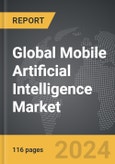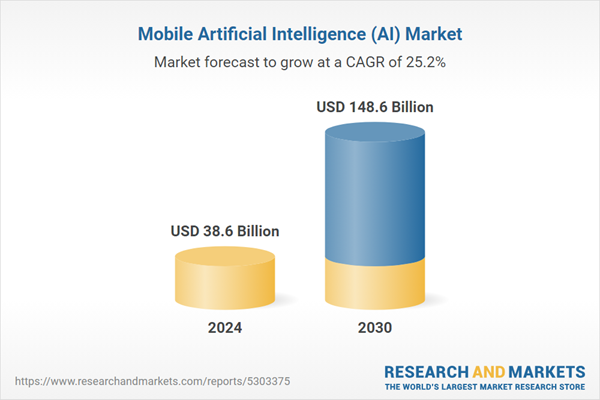The global market for Mobile Artificial Intelligence (AI) was valued at US$38.6 Billion in 2024 and is projected to reach US$148.6 Billion by 2030, growing at a CAGR of 25.2% from 2024 to 2030. This comprehensive report provides an in-depth analysis of market trends, drivers, and forecasts, helping you make informed business decisions. The report includes the most recent global tariff developments and how they impact the Mobile Artificial Intelligence (AI) market.
Segments: Technology Node (5-10 nm, 11-20 nm, Above 20 nm); Application (Smartphones, Cameras, Drones, Automotive, Robots, Other Applications).
Geographic Regions/Countries: World; United States; Canada; Japan; China; Europe (France; Germany; Italy; United Kingdom; and Rest of Europe); Asia-Pacific; Rest of World.
The analysts continuously track trade developments worldwide, drawing insights from leading global economists and over 200 industry and policy institutions, including think tanks, trade organizations, and national economic advisory bodies. This intelligence is integrated into forecasting models to provide timely, data-driven analysis of emerging risks and opportunities.
Global Mobile Artificial Intelligence (AI) Market - Key Trends and Drivers Summarized
How Is Mobile Artificial Intelligence (AI) Transforming Mobile Technology?
Mobile Artificial Intelligence (AI) refers to the integration of AI capabilities into mobile devices, allowing them to perform advanced functions such as image recognition, natural language processing, and augmented reality in real-time. Mobile AI is rapidly changing how people interact with their devices, enabling more personalized, intelligent, and efficient user experiences. The development of AI-powered processors and machine learning algorithms optimized for mobile platforms has made it possible for devices to perform complex computations locally without relying on cloud-based processing. As a result, applications such as facial recognition, voice assistants, and predictive text are becoming more common across mobile devices, enhancing user engagement. The use of mobile AI extends beyond consumer applications, finding utility in sectors like healthcare, finance, and retail. In healthcare, for example, AI-powered mobile devices can assist in diagnosing medical conditions by analyzing images and patient data. In finance, AI can detect fraudulent activities by monitoring transaction patterns in real-time. AI-powered chatbots and virtual assistants are being used to improve customer service in retail, providing real-time support and personalized product recommendations. The broad range of applications is expanding the addressable market for mobile AI, driving innovation across various industries.What Technological Innovations Are Driving Mobile AI Market Growth?
Technological innovations in mobile AI are focused on enhancing the processing power and efficiency of AI chips, optimizing machine learning algorithms for mobile environments, and improving data privacy. The development of dedicated AI chips, such as Neural Processing Units (NPUs), has significantly increased the computational capabilities of mobile devices, allowing for faster and more energy-efficient AI processing. Additionally, advancements in machine learning techniques, including federated learning, enable mobile AI to learn and improve on-device while maintaining data privacy by keeping user data local. Another key trend is the integration of AI across mobile operating systems, enabling a seamless AI experience across different applications. AI-based edge computing is also gaining traction, allowing mobile devices to perform tasks that previously required cloud-based processing, such as real-time translation and augmented reality applications. The deployment of 5G technology is further enhancing mobile AI capabilities by providing the high-speed connectivity needed for latency-sensitive applications, such as autonomous driving and remote healthcare.How Do Market Segments Define the Growth of Mobile AI?
Technologies include deep learning, machine learning, computer vision, and natural language processing, with deep learning being the most widely used for tasks such as image recognition and voice assistants. Applications of mobile AI span across sectors such as consumer electronics, healthcare, automotive, and financial services. Consumer electronics represent a significant market share, driven by the increasing demand for AI-powered smartphones and wearable devices. Regionally, North America dominates the mobile AI market due to the presence of major technology companies and a high level of smartphone penetration. However, Asia-Pacific is witnessing the fastest growth, supported by rapid technological adoption, increasing investment in AI research, and the proliferation of smartphones in countries like China and India. The European market is also expanding, driven by initiatives to integrate AI into various sectors, including healthcare and automotive.What Factors Are Driving the Growth in the Mobile AI Market?
The growth in the mobile AI market is driven by several factors, including the increasing adoption of smartphones, advancements in AI chip technology, and the integration of AI across various applications. The rising demand for intelligent and personalized user experiences is encouraging manufacturers to incorporate AI features in mobile devices. The development of AI-specific processors is enabling real-time AI functionalities, making applications like facial recognition and augmented reality more accessible. Furthermore, the rollout of 5G networks is expanding the potential of mobile AI by supporting high-speed, low-latency applications such as autonomous driving and telemedicine.Report Scope
The report analyzes the Mobile Artificial Intelligence (AI) market, presented in terms of units. The analysis covers the key segments and geographic regions outlined below.Segments: Technology Node (5-10 nm, 11-20 nm, Above 20 nm); Application (Smartphones, Cameras, Drones, Automotive, Robots, Other Applications).
Geographic Regions/Countries: World; United States; Canada; Japan; China; Europe (France; Germany; Italy; United Kingdom; and Rest of Europe); Asia-Pacific; Rest of World.
Key Insights:
- Market Growth: Understand the significant growth trajectory of the 5-10 nm segment, which is expected to reach US$72.6 Billion by 2030 with a CAGR of a 24.9%. The 11-20 nm segment is also set to grow at 26.6% CAGR over the analysis period.
- Regional Analysis: Gain insights into the U.S. market, valued at $11.3 Billion in 2024, and China, forecasted to grow at an impressive 24.5% CAGR to reach $22.7 Billion by 2030. Discover growth trends in other key regions, including Japan, Canada, Germany, and the Asia-Pacific.
Why You Should Buy This Report:
- Detailed Market Analysis: Access a thorough analysis of the Global Mobile Artificial Intelligence (AI) Market, covering all major geographic regions and market segments.
- Competitive Insights: Get an overview of the competitive landscape, including the market presence of major players across different geographies.
- Future Trends and Drivers: Understand the key trends and drivers shaping the future of the Global Mobile Artificial Intelligence (AI) Market.
- Actionable Insights: Benefit from actionable insights that can help you identify new revenue opportunities and make strategic business decisions.
Key Questions Answered:
- How is the Global Mobile Artificial Intelligence (AI) Market expected to evolve by 2030?
- What are the main drivers and restraints affecting the market?
- Which market segments will grow the most over the forecast period?
- How will market shares for different regions and segments change by 2030?
- Who are the leading players in the market, and what are their prospects?
Report Features:
- Comprehensive Market Data: Independent analysis of annual sales and market forecasts in US$ Million from 2024 to 2030.
- In-Depth Regional Analysis: Detailed insights into key markets, including the U.S., China, Japan, Canada, Europe, Asia-Pacific, Latin America, Middle East, and Africa.
- Company Profiles: Coverage of players such as Alphabet Inc. (Google), Apple, Facebook, Inc., Hailo, Huawei Technologies Co., Ltd. and more.
- Complimentary Updates: Receive free report updates for one year to keep you informed of the latest market developments.
Some of the 88 companies featured in this Mobile Artificial Intelligence (AI) market report include:
- Alphabet Inc. (Google)
- Apple
- Facebook, Inc.
- Hailo
- Huawei Technologies Co., Ltd.
- IBM
- Imagimob AB
- Intel Corporation
- MediaTek Inc.
- Microsoft
- NVIDIA
- Qualcomm, Inc.
- Samsung Electronics
Tariff Impact Analysis: Key Insights for 2025
Global tariff negotiations across 180+ countries are reshaping supply chains, costs, and competitiveness. This report reflects the latest developments as of April 2025 and incorporates forward-looking insights into the market outlook.The analysts continuously track trade developments worldwide, drawing insights from leading global economists and over 200 industry and policy institutions, including think tanks, trade organizations, and national economic advisory bodies. This intelligence is integrated into forecasting models to provide timely, data-driven analysis of emerging risks and opportunities.
What’s Included in This Edition:
- Tariff-adjusted market forecasts by region and segment
- Analysis of cost and supply chain implications by sourcing and trade exposure
- Strategic insights into geographic shifts
Buyers receive a free July 2025 update with:
- Finalized tariff impacts and new trade agreement effects
- Updated projections reflecting global sourcing and cost shifts
- Expanded country-specific coverage across the industry
Table of Contents
I. METHODOLOGYII. EXECUTIVE SUMMARY2. FOCUS ON SELECT PLAYERSIII. MARKET ANALYSISIV. COMPETITION
1. MARKET OVERVIEW
3. MARKET TRENDS & DRIVERS
4. GLOBAL MARKET PERSPECTIVE
UNITED STATES
CANADA
JAPAN
CHINA
EUROPE
FRANCE
GERMANY
ITALY
UNITED KINGDOM
REST OF EUROPE
ASIA-PACIFIC
REST OF WORLD
Companies Mentioned (Partial List)
A selection of companies mentioned in this report includes, but is not limited to:
- Alphabet Inc. (Google)
- Apple
- Facebook, Inc.
- Hailo
- Huawei Technologies Co., Ltd.
- IBM
- Imagimob AB
- Intel Corporation
- MediaTek Inc.
- Microsoft
- NVIDIA
- Qualcomm, Inc.
- Samsung Electronics
Table Information
| Report Attribute | Details |
|---|---|
| No. of Pages | 116 |
| Published | April 2025 |
| Forecast Period | 2024 - 2030 |
| Estimated Market Value ( USD | $ 38.6 Billion |
| Forecasted Market Value ( USD | $ 148.6 Billion |
| Compound Annual Growth Rate | 25.2% |
| Regions Covered | Global |









